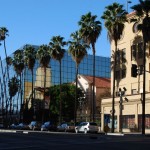Los Angeles (USA, California)
Los Angeles (also known as L.A. or City of Angels) – is a city in the USA, in the south of California State and on the coast of the Pacific Ocean. It is the biggest city of the state by population and second biggest in the country (as of 2006 – 4,097,000 citizens). The city is a center of so called Greater Los Angeles Area – an agglomeration populated by more than 17 million people. Los Angeles citizens are also called «Angelenos».
Los Angeles – is one of world’s largest cultural, scientific, business, and educational centers. The city is also one of the biggest centers of entertainment industry in the world (motion pictures, music, and television production).
The district where the present-day city is located was populated by indigenous North Americans for many thousand years. The coastal area, where Los Angeles lies now, was settled by the Tongva, Chumash and other Native American tribes for centuries. Europeans arrived here first in 1542, when Californian coast was visited by an expedition of a Spanish pioneer Juan Cabrillo.
Los Angeles was founded on September 4, 1781 under the name of El Pueblo de Nuestra Señora la Reina de los Ángeles sobre El Río Porciúncula (The Town of Our Lady the Queen of the Angels on the Porciúncula River, in Spanish) by a group of Spanish colonists of forty six people. For a few decades the new settlement remained as a small town, but by 1820 its population reached 650 people, to make it the largest civil settlement in Spanish California.
After the declaration of Independence by Mexico State, Los Angeles was included in its territory. In 1847, during the American-Mexican war, the city passed on to the United States. In 1850 Los Angeles received the status of a city.
In 1876, Southern Pacific Company finished building the railroad to Los Angeles. The future development of the city was prompted by the discovery of oil in the area of the city in 1892. In 1923, in Los Angeles region one forth of the entire productions of gasoline in the world was concentrated. In 1913, construction of an aqueduct was completed to supply water for the needs of the growing city. In the 1920s, the motion picture and aviation industries flocked to Los Angeles. In 1932 the city hosted X Summer Olympics.
With the beginning of the World War II the development of the city received a new impulse. At this period a number of German scientists, artists and writers moved to Los Angeles as they fled from Nazism (among them are Lion Feuchtwanger, Thomas Mann, Fritz Lang, Berthold Brecht and others). At the same time one has to indicate the fact that during the war thousands of Japanese Americans were interned to enclosed camps.
In the post-war years the city boomed and sprawled: many business centers and traffic intersections were built. In 1984, Summer Olympic Games were held in Los Angeles again, but athletes from Socialist camp countries did not take part in them. In 1992 the city became the scene of large-scale riots and violence, caused by racial controversies; and in 1994 it survived a devastating earthquake which damaged many buildings and objects of the city’s infrastructure. After these events campaign for the seceding of Hollywood and San Fernando Valley from Los Angeles became prevailing but the general vote of 2002 did not allow these plans to be fulfilled.

